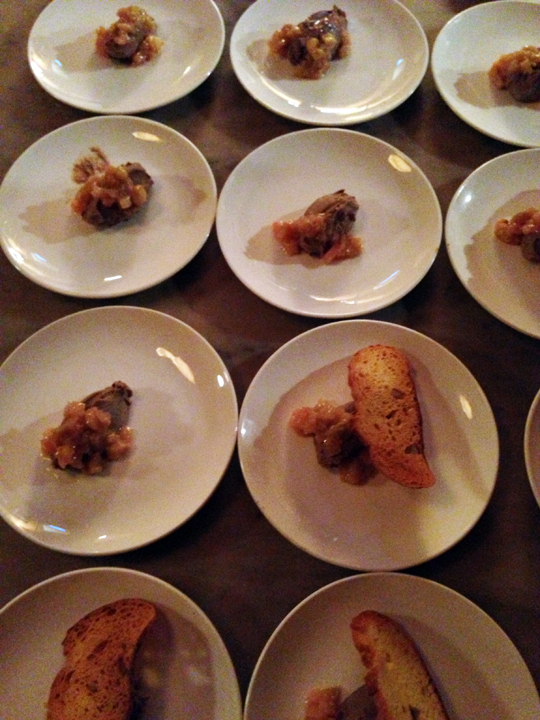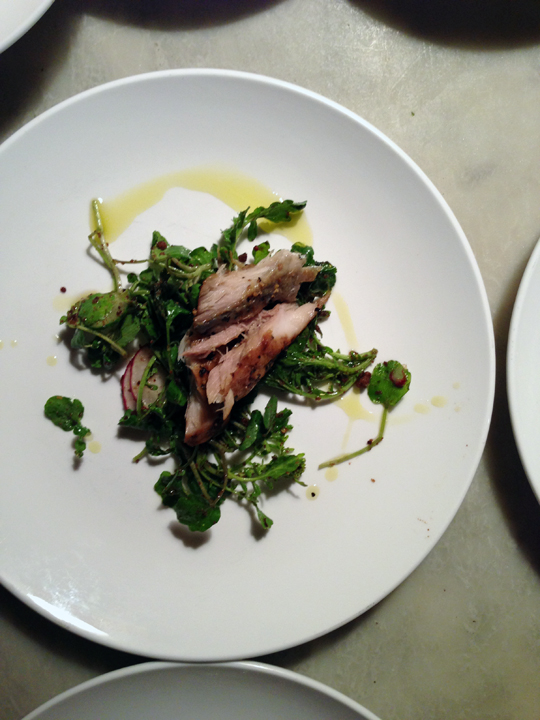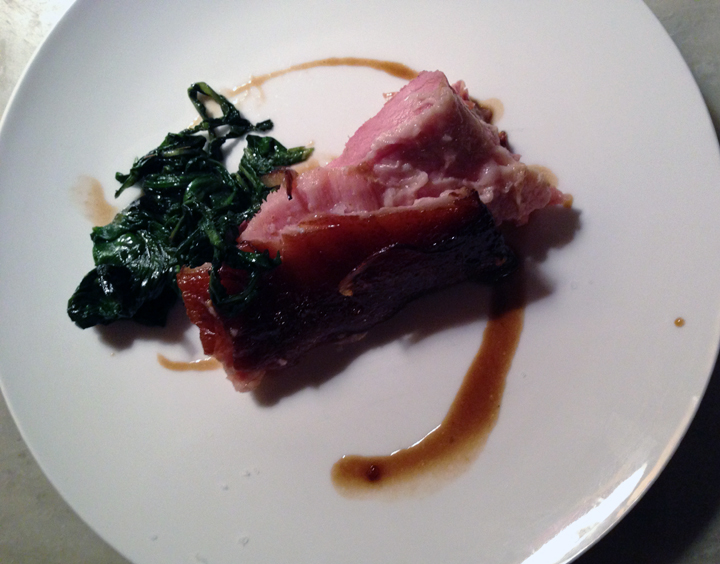Grano Arso Pasta inspired by Chef Patti Jackson
/All culinary and artisan roads lead to Jimmy Carbone, the owner of Jimmy's No. 43; a Slow Food approved restaurant and craft beer bar in the East Village of New York City. Thankfully, Jimmy's is a five minute walk from my New York City apartment, as their Monday night prix fixe dinner series is about imbibing craft beers with a chef prepared, locally focused meal that is not to be missed; especially if Chef Patti Jackson, formerly of iTrulli, is cooking.
In 2011, I met chef Jackson at my first Cassoulet cooking competition at Jimmy's No. 43. She was stationed right next to me and I was so excited to meet the chef of iTrulli, as I thought her talent for developing Italian fare, especially her pasta, was right on. I am very much inspired by chef Jackson and have been fortunate enough to indulge at a few of these dinners: Spanish tapas paired with hard ciders and Spanish beers of Iberian United, Vegetarian Nonsense™ Dinner paired with Italian craft beer curated by B. United, and most recently April Sours, featuring lambic and sour beers paired with a special tasting menu which included:
- Chicken Liver Pate, Rhubarb Relish paired with Hanssens Gueuze
- Smoked Mackerel Salad with Cress and Rye Crumbs paired with Alvinne Wild Undressed
- Burnt-flour Pasta with Duck Sausage and White Beans paired with Vapeur, Vintage
- Braised Bacon, Braised Spring Greens and Ramps paired with Vapeur Cochonne 1996
- Savory Cheese Tart, Fig and Cardamon Toast paired with Alvinne Cuvee Freddy
I have eaten and made my fair share of pasta, but I have never heard of the burnt flour type, known as, grano arso, which means burnt grain. Grano arso originated in the region of Puglia as cucina povera, or "cuisine of poverty". There’s more than one story about the origin of using grano arso. Some say hungry peasants scoured freshly burned wheat fields seeking overlooked scorched stubbles, while another theory suggests that villagers would sweep their communal wood-burning ovens to collect the burnt flour that was left behind after baking bread. Today, burnt grain is not a necessity for survival, but of interest to the experimental cook or chef like Patti Jackson.
I was so inspired by chef Jackson's burnt flour recipe that I experimented the following day in my kitchen and followed her technique.
Tagliatelle di Grano Arso with Spring Peas, Asparagus and Caramelized Onions
Chef Jackson made a Maccheroncini pasta which are pasta tubes, that she cut into 1-inch pieces. I decided to make a Tagliatelle pasta that are long and flat which held the ingredients nicely. My burnt flour could have taken another 5 minutes in the oven, however, my smoke detector was not happy, alarming me of when it thought the flour was done, so I had to stop. Be sure to open the windows or us your oven vents. The flavor of the burnt flour pasta is exactly like charred pizza dough and the color — a dark, toasted amber similar in color to cocoa powder.
Grano Arso
ingredients
- 1 cup; durum flour
directions
- Preheat oven to 400°
- Spread flour on a baking sheet and bake for 30 - 40 minuets; until dark in color and charred on the edges.
- Remove from oven and let cool. Sieve in a bowl; reserve.
Tagliatelle di Grano Arso
ingredients
- 1 cup; grano arso
- 3 cups; durum flour
- 1 cup; hot water
Note: for this recipes 2 pieces of dough was used. The remainder you can freeze, 1 -3 months.
directions
- Place grano arso and flour in the bowl of a stand mixer fitted with dough hook.
- Slowly add the hot water and mix until moist and capable of sticking together
- Remove dough from mixer and place on a lightly floured work surface; knead by hand to form an elastic ball and divide into 4 pieces and cover with plastic wrap.
- Flatten your 1 piece of dough a little and feed it through the machine, set to #1.
- Fold the dough in half and feed it through the machine again, still on #1.
- Repeat this process around 10 times.
- Change your setting to #2 and feed it through the machine once. No need to fold the dough in half again.
- Using the Tagliatelle pasta attachement feed the pasta through, lightly flour pasta on a baking sheet and let dry for 15 minutes.
- Continue with Step 1-8 with the remaining pasta pieces.
Assembly
ingredients
- 1 cup, spring peas
- 12 stalks of asparagus, cut into 1/2 inch pieces
- 1 large onion, thinly sliced
- 3 tablespoons of olive oil
- 1 tablespoon of unsalted butter
- 3/4 cup of grated Pecorino cheese
- 1 tablespoon of cracked black pepper
- Generous amount of salt for the pasta water and for blanching the peas and asparagus.
- 1 cup of reserved pasta water
directions
- Over medium heat in a wide skillet add 1 tablespoon of butter and 1 tablespoon of olive oil. Add the onion and caramelize until golden brown; set aside.
- Bring a medium size pot of salted water to a boil and add the peas and cut asparagus; blanch for 2 minutes; strain and reserve.
note: before cutting asparagus snap off the woody base of each spear by bending the spear a few times to find a place where it breaks easily.
- Place vegetables with the caramelized onions and lightly fold together over low heat; reserve.
- Bring a large pot of salted water to a boil; cook until al dente, for about 3 minutes; remove pasta with a wide strainer and place in the pan with the vegetables.
- Add 1 cup of the reserved pasta water, 2 tablespoons of olive oil and 3/4 cup of grated pecorino cheese.; gently fold together.
- Place in a bowl or serving dish and lightly sprinkle with pecorino cheese.

































